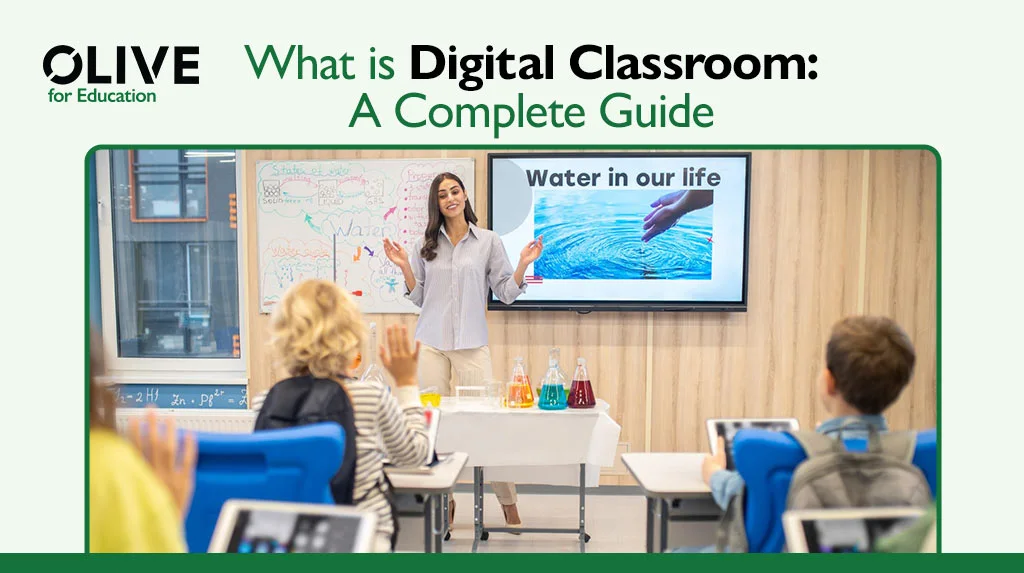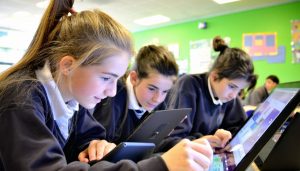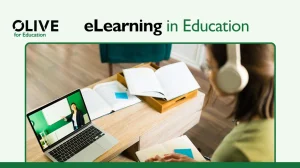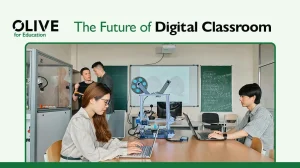Technology has always played a central role in every sector. The digitalisation of every sector has brought many benefits to us. The education sector has been impacted the most as its evolution has shifted the traditional teaching methods to innovative digital classrooms.
A digital classroom expands upon the traditional classroom’s four walls taking the learners out to a place where they can think and interact in ways that were unimaginable a short time ago.
This blog will educate you about the digital classroom, including its features, benefits, and obstacles, and how to establish an effective digital classroom with professional guidance.
What is a Digital Classroom?
A digital classroom is a learning environment that enhances traditional teaching with digital tools and technologies. Hardware, software, and internet connectivity integration are required to enable interactive, efficient, and student-centered learning. In other words, a digital classroom is a place where technology is used to provide more accessible, engaging, and efficient education.
Innovative tools such as Microsoft Teams, Google Classroom, and Senso have significantly helped in enhancing the learning experience for students. These tools help students better understand their assignments, learn interactive topics with the help of STEM, and enable seamless communication with the help of video meetings, chat, and file sharing.
Key Features of Digital Classroom
Technology is used in digital classrooms to design interactive, personalised, and very efficient learning environments to link the traditional methodology of teaching to the present innovation. Every digital classroom’s feature plays a big part in improving teaching and learning. These key features help digital classrooms to be more engaging, simple, and future-friendly.
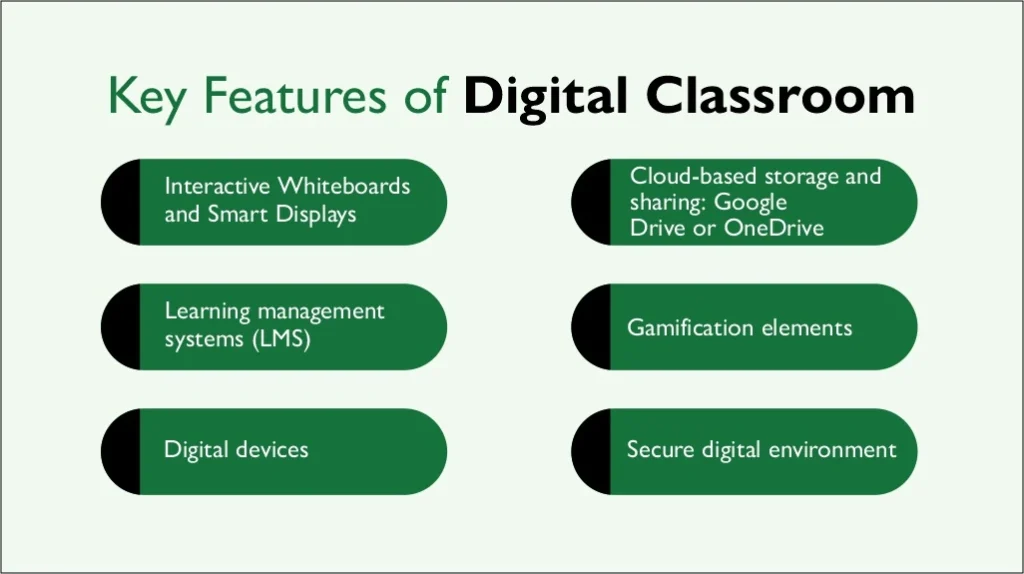
Some of the key features of digital classrooms are as follows:
- Interactive Whiteboards and Smart Displays: By using modern smart boards, teachers can draw, write, and share content directly onto the screen. It makes learning more visual and easy to understand.
- Learning management systems (LMS): Teachers save a lot of time because of tools such as Google Classroom or Moodle, as they can upload lessons, set assignments, and monitor performance.
- Digital devices: There are many ways in which students can learn lessons, watch videos, or do assignments using a tablet, laptop, or even smartphone.
- Cloud-based storage and sharing: Google Drive or OneDrive are some of the cloud services where we can keep our files, access them with the help of the internet, and share them.
- Gamification elements: Tools such as Kahoot! or Quizizz enhance learning through interactive quizzes and games.
- Secure digital environment: Digital classrooms are secure, so they can protect student’s information and have a safe online interaction
Importance of Digital Classrooms
Digital classrooms are not just technological gimmicks, they exist to change the delivery and experience of education. It offers them a more efficient learning environment and one which they pay better attention to. Digital classrooms are revolutionizing the face of the educational sector with equitable education and a forward teaching method.
Here are some of the key importance of digital classrooms are as follows:
- Personalised learning experience: Technology makes learning easier because applications can adapt to the rate and manner of study of a learner.
- Enhanced student engagement: Learning becomes fun with video guides, animations, and interactive activities that demonstrate various technology and website-building skills.
- Real-time collaboration and communication: Students and teachers can communicate instantly face to face, chat, or share documents, even if they are in different places.
- Flexibility in learning: Students’ ability to learn whenever and wherever they want means that they can easily balance school with their busy lives.
- Data-driven insights: Teachers can use data from digital tools to assess their students’ performance and adjust their teaching.
- Skill development for the future: Using digital tools, students learn the important tech skills they’ll need for their next career.
What are the Components of a Digital Classroom?
The successful integration of digital classroom components relies on seamless digital classroom components. All of them help to build proper and effective learning conditions.
Some of the important components of digital classrooms are as follows:
1. Hardware
Digital classrooms cannot be established without the physical hardware devices that make up the foundation. These include interactive boards, projectors, computers, and tablets. Through interactive boards, teachers can visually represent concepts and make the lesson more interesting and follow.
Multimedia content is displayed with projectors and both teachers and students can access online resources, participate in activities, and collaborate online using computers and tablets. It makes learning more immersive and more visually appealing.
2. Software and Tools
Digital classrooms are based on software applications and digital platforms. Communication and collaboration are made easier with tools like Microsoft Teams and Google Workspace that can provide virtual meetings, real-time discussions, and lesson planning.
These tools make it easy for teachers to create tasks, register updates, and give feedback at ease. Moreover, platforms, such as Kahoot and Paradiso, offer an interactive element of learning in which the student can participate.
3. Internet Connectivity
A digital classroom requires a stable fast internet connection. It ensures uninterrupted online information sources and video streaming for continued communication with teachers and students. If the digital learning tools and platforms do not have reliable connectivity for their efficiency, it may impact the pace of learning as well as engagement levels.
4. Classroom Management Tools
Administrative functions are made smooth and there is good organisation through the use of social aids like classroom management tools. Senso offers a platform where a teacher can monitor attendance, watch his or her student’s behaviour, and track assignments. These tools give teachers a glimpse into student performance and allow them to pinpoint weaker areas and build out a structured environment to study in.
5. Digital Content
High-quality digital content is needed to make a lesson interesting and informative. It provides educational videos, eBooks, interactive simulations, and animations to make difficult topics easier.
A simulation of a geochemistry experiment enables students to visualise a process that is hard to repeat in a real classroom. The dynamic content makes things more interesting, which keeps students engaged, and has an impact on comprehension and understanding.
What are the Challenges of Digital Classroom?
Digital classrooms have revolutionised education, but they come with challenges that must be addressed for effectiveness. To make the learning environment more inclusive and efficient, it’s important to understand the different barriers to it from accessibility problems to technical ones.
Some of the challenges of digital classrooms are as follows:
- Digital divide and accessibility issues: Many students have no access to devices or the internet so can’t join digital classrooms.
- Technical challenges and infrastructure costs: Digital classrooms can require significant investment and are a little technical to set up and manage.
- Cybersecurity and data privacy concerns: For schools and institutions, one of the big challenges can be the protection of sensitive information such as student data.
- Teacher adaptation and digital literacy: Digital tools may require teachers to be trained before they can be used in learners’ lessons to their maximum potential.
How Olive Helps in Digital Classroom?
Olive for Education (OFE) enables schools to introduce digital learning without any barriers. We offer schools specific solutions that fit their individual needs with the promise that every educator can be successful. OFE is dedicated to enabling digital education, from providing a secure environment to interactive content paired with a curriculum that’s perfect for teaching daily. This approach keeps students engaged and allows teachers to feel comfortable in using new technology in their classrooms.
Commitment towards continued support makes OFE different from others. It’s not only the tools we offer, our team also teach educators to use the tools effectively. OFE guides schools through exercises to unlock the full potential of digital learning, with hands-on guidance and continued assistance. Empowering teachers and building a foundation for success. Olive for Education is more than a technology provider, we view ourselves as a partner in shaping the future of learning.
The Future of Digital Classroom
A digital classroom is not a trend but a viable model for future education. While the learning experience is becoming more and more integrated with artificial intelligence (AI), augmented reality (AR/VR), and big data analytics, there’s a lot more to come in the future.
In addition, 5G and advances in broadband will bring faster and more reliable connectivity so that digital classrooms will be available in remote and underserved areas. This shift is going to democratise education to bridge gaps and spread inclusivity. In the coming years, digital classrooms will play a pivotal role in developing future-ready individuals equipped with critical thinking, creativity, and technological prowess.
Read more 👉: The Future of Digital Classroom
Wrapping Up!
Digital classrooms are the future of education which combines technology instruction to create a more engaging and efficient method of learning. The benefits are enormous, from personalised learning experiences to strengthening global connectivity.
With this digital transformation all around the globe, education institutes must follow this revolution to meet the changing needs of learners and educators.
FAQs
What are the benefits of digital classrooms for students?
Digital classrooms offer personalised learning, increased engagement, and access to global resources, preparing students for a tech-driven future.
Can digital classrooms replace traditional classrooms?
While digital classrooms provide unparalleled advantages, a hybrid model that combines both traditional and digital methods is often the most effective.
What tools are needed to set up a digital classroom?
Key tools needed to set up a digital classroom include interactive whiteboards, LMS platforms, digital devices, and stable internet connectivity.
How do I engage students in a digital classroom?
To engage students in a digital classroom, you can use interactive content, gamification, real-time collaboration tools, and personalised learning strategies.

